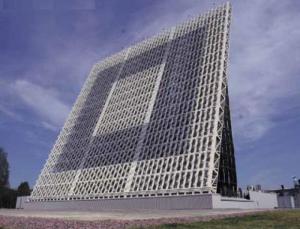Despite financial difficulties, the Russian defense industry has made many new achievements in various fields, especially the rapid and powerful development of Russian radar systems. Success in creating long-range radar systems “Voronezh” series was beyond their expectations.
In 2013, many believed that seven out of nine radar stations would not be ready for combat by 2018, but at the end of 2017, Russia officially announced the equipping of one radar station “Voronezh-M” and two stations “Voronezh” . -DM.” These three new Russian radar systems allow Russia to monitor the situation in both China and the Middle East region.
In addition, two more radar stations of this type are in the process of being installed in the south of Russia and they are responsible for monitoring the situation in North America. Russia’s 10th radar station will be deployed in Crimea. The reason why Russia hastened the progress of equipping new-generation radar stations to detect and counter US and Western attacks.
In addition, the costs for maintenance, maintenance and operation of these new stations are lower than the old ones, thanks to the new technology, they are more reliable and have better combat capabilities. Therefore, Russia will continue to carry out the replacement of their old generation radar stations.

Russia has regained the ability to detect missiles thousands of kilometers away.
According to the plan , the new system “Voronezh” will replace the “Daryal” system (used to detect ballistic missiles) and then gradually replace the old systems from the Soviet era.
Previously, in 2013, Russia officially stopped using the “Daryal” system in Azerbaijan, because the Azerbaijani side raised the rental cost from 7 million USD per year to 300 million USD. Russia refused this request and proceeded to dismantle this radar station in Azerbaijan, ending the 10-year lease on December 24, 2012.
This radar station started in 1983 and is planned to become one of the strategic radar systems of Russia. However, after the end of the cold war this project was stopped and Russia only created one more “Daryal” system in the north of Russia.
This “Daryal” system is responsible for detecting missile launches in North America in the direction of the North Pole. Meanwhile the radar station in Azerbaijan covers the entire Middle East and India. However, now this task will be handed over to the new system Voronezh and they will be deployed on the Black Sea coast.
In fact, after the end of the contract, Russia has proposed to continue deploying the Russian radar station in Azerbaijan and is willing to pay a larger fee, but of course not an additional $ 293 million. Even Russia is willing to pay Azerbaijan about 5 million USD more for electricity and about 10 million USD for other services every year. It should be remembered that this radar station will provide jobs for about 500 Azerbaijanis and 1100 Russians. However, Azerbaijan seemed to want to prove it did not want to be dependent on Russia and decided not to agree.
In 2012 the fourth radar station of the “Voronezh” series was deployed near Irkutsk. This is the first of three radar stations to be deployed in eastern Russia. The next two radar stations will be deployed in 2017. Stations deployed in the west of the country cost only about 50-70 million USD per year, while the station in the east is higher with 100 million USD.
The Voronezh system (as well as the Daryal) is capable of detecting missiles at a distance of 6,000km. From 2005 to 2011, three stations Voronezh-M and Voronezh-DM were deployed in the western part of Russia. The first radar station is deployed near Kaliningrad on the Baltic Sea, the second near the east coast of the Black Sea (Armavir), and the third – on the east side of the Baltic Sea near St. Petersburg.
Russia has been actively developing radar systems since the collapse of the Soviet Union and it is no longer capable of detecting ballistic missiles. In fact, the Soviet Union had many of these systems, but after the dissolution of the 14 republics, one by one, the countries split up and then these systems belonged to them. However, disputes as well as the possibility of some republics or civil wars have rendered these systems obsolete or “retired” . Two Ukrainian stations of this type were also officially discontinued in 2010.
The high oil price in the period 1990-2013 allowed Russia to invest actively to restore the ballistic missile detection system. The first radar station (located near St Petersburg) was created after only a year and a half. It replaces an old station, which was built in 10 years. Thanks to the new design, advanced technology and high automation, this system consumes less electricity, requires less service, and is easy and quick to install thanks to its modular design.
Since the collapse of the Soviet Union, Russia has applied many Western technologies combined with their research to create new generation stations. The radar station was deployed near St. Petersburg to replace the one in Latvia that was decommissioned in 1998 and dismantled in 2003. The new radar station in Armavir performs the same tasks as the earlier stations in Azerbaijan and Ukraine. .
With this new implementation all missile attacks are detected by Russia from whatever direction it appears. This system also allows Russia to collect a lot of different data, and this allows it to assess in detail the progress of other countries in ballistic missile development. According to the Russian Defense Ministry, in 2017, the radar station recorded 50 ballistic missile launches.

